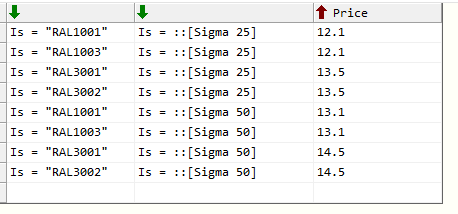Variables of type MDT are decision tables.
Decision tables are structural elements of a class.

Example of an unbound decision table
For an unbound decision table, not all columns are connected to a variable. The check of such a table is done with the function CheckByParam.

Example of a partially bound decision table
For a partially bound decision table, only the output columns are connected to a variable. The check of such a table is done with the function CheckByInValues.

Example of a bound decision table
In a bound decision table, all columns are connected to a variable. The Rules switch can be used to provide the decision table with rules that determine under which circumstances the decision table is included in the rule check process.
If the Rules switch is off, the decision table can only be checked with the Check, CheckByParam or CheckByInValues functions.
How decision tables work
A decision table has at least one input column and at least one output column.
Starting from the first row and descending, the individual fields of the inbound columns are checked to see if their logical expression returns True.
In each input field, the check value is represented by the key term Is. The test value is a value of the test variables converted to Variant for bound columns.
In the above bound decision table, the actual test expressions are
Sigma = "Sigma 25", Sigma = "Sigma 50", Sigma = "Sigma 75"
If no expression is stored in an input field, this field is not relevant and is implicitly interpreted as logical true.
If all input fields of a line return a logical true, a hit is determined. Then the output fields of the output columns of this hit row are edited.
The values are written back to the output variables and the editing of the decision table is completed.
Attribute Properties and Functions: